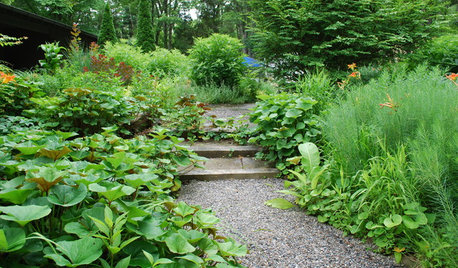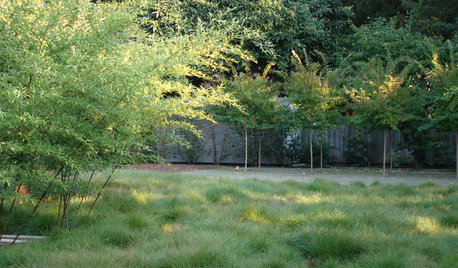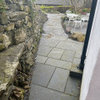Americans Scalp Their Lawns
I've been ahead of the curve on MANY things. Remember trans fats? I know about them a decade before they became a news item. I would talk about how they were toxic in the mid to late 90s and people would look at me like I was crazy.
I'm just going to drop a bomb in a forum that already seems beset with drama (LOL) and see what happens. Most people are absolute idiots about cutting height. Almost everyone in my neighborhood seems to cut on the lowest setting possible. "Yeehaw, turn it up to 11!" "Gots to get my money out of muh Home Depot tractor, cuz if I didn't set it to the lowest setting, I wouldn't." So these "lawns" just become dominated by crab grass in the summer, and annual low growing weeds in winter. Since my idiotic neighbors bought and cleared a lot that had become overgrown with weedy 'jungles' (but at least had tall fescue grass in the open sections) low growing things like Cerastrium are blowing in by the boat load. I can literally see a 'concentration gradient' - the parts of my lawn closer their theirs is full of it. Same with the crab and goose grass. They also turn brown the minute we get a dry spell, at least until the crab gets fully established by mid-summer. And since they take vacations to see their mountain kin, periodically, in summer, it has a chance to "get long", meaning a half acre of goddamn crab grass seeds blowing into my yard.
Why don't these morons just have astroturf? It would look much better, take much less time and effort to "maintain", not disturb me with the sound of their lawnmower every 3rd or 4th day, and not create so much fossil fuel emissions.
I cut at the highest setting on my Kubota (i.e, 4 inches, not the MMM carrying position which would cut at something like 8"). Lawn naturally resists weeds, other than the onslaught from next door. Looks great all year until covered by the first snow, or a prolonged drought. I am seriously starting to wonder if the reason deer are such a problem in American suburbia is there is no grass for them to eat!!! I'm not sure this is true but the few times I have seen them in my yard, they appear to be grazing on the grass! Their teeth wouldn't make much progress on my neighbor's 3/8th inch blades of "grass".
Some environmental organization needs to sponsor research on this if it hasn't happened already. The lower you cut, the more often you have to cut. It's simple math. Everyone attempting to make their lawn look like a putting green, and failing miserably, is hugely wasteful and dumb.
Comments (38)
beesneeds
3 years agoLol, I don't understand the obsession with perfect lawns in general- but it is an easier way to garden a lot of space than actual gardening.
Around here (I live rural) the desire to scalp the yards is ticks. I live in a rather bad tick area, so some folks keep their lawns super short all the time. It also helps a LOT with tamping down the dig-ups from various ground critters too.
I'm not that fussy, my yard gets tall enough to bloom between cuttings- I let the weeds and flowers grow as they will. I harvest wild chives and various greens and blooms out of my lawn before and between cuttings too. One of my neighbors down the road does goat-mowing to a great extent.
davidrt28 (zone 7) thanked beesneedsdavidrt28 (zone 7)
Original Author3 years agoOK I am well aware of the 'tick theory'. Wonder if there's any research to back it up. I have NEVER gotten ticks from walking in my lawn, even when I've let it get pretty long like 6-7". I really think they prefer taller grass than that: I do get them in the lowest, wetland part of my yard (lot slopes towards a brook) that I do not normally mow but once or twice a year, but the grass there gets to be 4' or so. It usually gets dry enough to carefully cut it in fall, although I did get my tractor stuck once and had to have it wenched out by a wrecker!
BTW having a wetland like that is great. No mosquitoes because the copious frogs and toads eat the larvae...in fact I am sure I have fewer than 'regular' suburbia. They also eat slugs so my plants are not bothered by them. At night the toads hop up to my front door and eat insects all night. Too many wetlands and marshes were foolishly drained "for health".
Related Professionals
Galveston Landscape Contractors · South Portland Landscape Contractors · Westchester Landscape Contractors · Northlake Landscape Contractors · Glendale Decks, Patios & Outdoor Enclosures · Forney Swimming Pool Builders · Willoughby Swimming Pool Builders · Mountain Brook Landscape Architects & Landscape Designers · Roxbury Crossing Landscape Architects & Landscape Designers · Belmont Landscape Contractors · Boca Raton Landscape Contractors · Estelle Landscape Contractors · Middle River Landscape Contractors · Westford Landscape Contractors · North Aurora Landscape Contractorsrifis (zone 6b-7a NJ)
3 years agoTo answer your question in paragraph 3 of your opening post, David, we will need to know your state and county.
beesneeds
3 years agoYou are lucky you don't seem to live in a buggy area davidrt. Ticks are rampant here, in the lawns, weeds, gardens. I almost always pick up a tick or two in my yard and I'm out and about. I just dress for being out in the yard if it's over 55 degrees.
We get skeeters too, because it's a healthy wetland. And lots of amphibians along with a full round of other critters. I got ponds, meadows, and woods too on my property.
I do keep a bit of a mowed yard around the house and out front to the street. Along with a lot of gardens I'd rather spend my time on than mowing :)
davidrt28 (zone 7) thanked beesneedsDCF-Z6A
3 years agoCopious frogs and toads are all that's needed to keep mosquitoes at bay? HA!! I invite you to sleep in my yard some night. I'll have the calamine lotion ready with your coffee. 😂
lawniac
3 years agoCutting height depends on your grass type, and not everyone has fescue. Anyone with Bermuda should be cutting at the lowest setting of their mower. Kentucky Bluegrass should ideally be maintained at 2.5" or thereabouts. I prefer fescue maintained at 2.5 inches myself. I don't know of anyone that recommends scalping your fescue, so you're not ahead of any curve, it's just that people don't really care enough about their lawns to educate themselves on proper care practices.
Having said that, if you're not going to take care of your lawn, I much prefer a scalped pasture to a 6" jungle. We have copperheads around here.davidrt28 (zone 7) thanked lawniackrnuttle
3 years agoTICKS. They are not to be trifled. The first half dozen years we lived in this house, every time I did work in the yard I would come in with at least one tick.. After several month of not having the energy to do anything, I when to the doctor. They tested me for every thing and found that I had Rocky Mountain Spotted fever. I will be on antibiotics for 10 days.
Another person in our church also has been attached by the tick and has a diagnosed case of Lyme disease.The good thing is that I am too tired to cut the grass, so it is not being "Scalped". Hopefully after the end of the antibiotics I can get back to taking care of my yard.
davidrt28 (zone 7) thanked krnuttledavidrt28 (zone 7)
Original Author3 years agolast modified: 3 years agoDCF, I guess mine have a more voracious appetite than yours. Srsly the only places I've ever seen mosquitoes or their larvae are odd places that water accumulates in a way it cannot be accessed by amphibians, like my rain barrel. Which I now cover with a fine net. In fairness, I do have a problem with horse flies (are they the same as deer flies?) that I don't think typical suburbia does - nearest horses are a 1/2 mile away, but they seem to like the marshy areas. An electric fly swatter kills them.
Lawniac, if any of these hayseeds (no pun intended) actually knew what type of grass they had and bothered to take care of it and keep weeds out of their lawn, I'd be happy for them to cut at any height they please. As it is, there is almost nobody like that in the neighborhood. The was one guy, definitely the richest, who had full-service chemlawn for a while. He cut his lawn very low - not quite scalping - but it looked ok because it had no weeds. Then he went "concern for the environment" and dropped the lawn service. Weeds are now colonizing his lawn too. I'm talking about people who just let their lawn become a witches brew of crab, goose, Paspalum, and in shade, Microstegium.
So to your point about preferring to see scalping to a "jungle" of 6", fine. The grass being allowed to dominate at 6 inches, all other things being equal, will have a better chance of out-competing weeds. And I'd prefer that.
davidrt28 (zone 7)
Original Author3 years agoFair enough krnuttle. The first time I catch a tick in the mown part of my lawn, I will wonder if I am cutting it too high. Hasn't happened yet. Would be interesting to see a research paper actually proving a 1" cutting high versus 3" cutting height actually makes much of a difference. I myself will continue to doubt that it does.
lawniac
3 years agoThe grass being allowed to dominate at 6 inches, all other things being equal, will have a better chance of out-competing weeds.
Is there a research paper somewhere actually proving that?
Fact of the matter is, all things are not equal. Fescue is a cool season grass, and it will not outcompete warm season grasses like bermuda and crabgrass in the summer. A monospecies lawn is a very unbalanced ecosystem, you don't see such a thing occur anywhere naturally, and mother nature always strives towards balance.
So, between heat, drought, fungus, warm season grasses' superior ability to photosynthesize under those circumstances, and other native grasses which have had millions of years to adapt to the exact local conditions, you can rest assured that no matter how tall you cut it, unless you tip the balance with herbicide, you will eventually end up in the same spot - a pasture with a variety grasses, in addition to some of your original grass.Jonathan M
3 years agoThe university down the street has some fields of undeveloped land that are almost pure stands of tall fescue. It gets mowed down once a year and some weeds creep in here and there but then quickly goes back to fescue dominated.
It’s one of the rare grass/climate combinations I’ve seen that actually naturally form a monostand.
But that’s really an exception.
davidrt28 (zone 7) thanked Jonathan Mkrnuttle
3 years agoBased on your picture, it appears you live in an older established lot. We are about 25 miles east of Raleigh NC. 25 years ago addition was a cotton probably or tobacco field. 15 years ago this property was wooded and cleared when the addition was built. The addition is surrounded but wooded ravines, and on one end a swamp creek. The lots vary from about a half acre to an acre and a half, or more. Our 3/4 acre lot like most of the lots have some lawn and some of the original woods.
This is an entirely different situation than your lot.
Ticks are a constant problem, though in the last couple of years not as bad as when we moved in. As I said I want every one aware of the tick born diseases, they can be as deadly as the corona virus. Recently a friend in a similar environment got bitten and has a clinical diagnosed case of Lyme disease.Jonathan M
3 years ago32" high, wow. I vaguely remember you saying you kept it around 8" in some past post years ago. What height do you usually keep it?
My comment above was really regarding prairie/meadows existing as monostands of a single grass. A yearly mow isn't really "unmanaged", but usually there's a much wider mix of plants in the grasslands around here, lots of oxeye daisies and veronicas (or maybe they're larkspurs).beesneeds
3 years agoWow, we for sure have some different yards. I didn't realize how urban these yards folks are talking about are. Ticks often aren't as much as a problem in urban areas as they are in rural areas.
I'm really rural. My mowed yard is around 4 acres. We keep mown open another acre or so worth of trails on the back acres. Ticks are usually a problem in rural areas like mine.
Skip1909
3 years agoYou mow 4 acres? I hope you mean once a year? What would you even be doing on 4 acres of mown grass?
beesneeds
3 years agoNo, not once a year. Several times each summer. Depends on how fast the lawn blooms. Sometimes it's as quick as two weeks, usually more like 3-4 weeks. This year, first mow was right before Memorial day weekend, though it could have used it a bit sooner. Not so bad though, there was a delightful large clump of wild strawberries prime for pulling up out of the lawn and moving to a more tended garden. Now the lawn has it's yellow blooms starting to fade, and clover is starting to pop, so probably a mow this weekend depending on weather.
I have a lot of various gardens, a small orchard, and a goodly bunch of mature maples, evergreens, and some scrappy thing trees in my front yard. So it's nice to have a lawn to walk around on from here to there. Part of when to mow factor is when grass gets high enough to make it pttttht to use my wheelbarrows, it's time to mow.
I also have a few outbuildings like barns, and a couple fire pit areas in front, side, and back yards. The fire pit down by the swans pond in the side yard gets a wide mow open because otherwise the bugs are overwhelming, lol. Flying ones more than ticks though.
Out back where we just mow open the trails- at the same rate as the yard- it's just easier in some areas because otherwise the meadows just grow impassable with growth along the trails so quickly. We wouldn't be able to get out to where the best blackberry patches are or the other ponds and creek out back if we didn't mow open.
And really, my mowed yard is easy gardening. It's thick and plush, got all sorts of fun stuff growing in it. I don't sweat the scrappy spots, those grow in well enough too in time. Only needs a days or sometimes two mowing every few weeks. By comparison, my gardens need a lot more hours with more frequency for attention.lawniac
3 years agoI think we should all get rid of most of our lawns.
Why don't you get rid of yours and let others worry about what they grow on their own property.gardengal48 (PNW Z8/9)
3 years agoWhy is it that when any of the Lawn Care forum regulars get involved in discussions with participants of other forums, things always start to go nasty?
beesneeds
3 years agoUm, this thread is in the landscape design forum too, that's where I found it. As a landscaping thread, it isn't that odd for someone to suggest having less lawn.
It's kind of interesting to note how delicate lawn people are apparently. I had no idea.User
3 years agoUm, this thread is in the lawn care forum too, that's where I found it. As a lawn care thread, it's odd that somebody would suggest we should get rid of our lawns.
If you'd like, I can hang over in Landscape Design and demand you folks grow only what happens to naturalize in place from seed randomly because anything else defies nature and you should get rid of your designs. That would be fun.
It's kind of interesting to note how sensitive landscape design people are about lawns. I had no idea. You'd probably better avoid the lawn care forum in the future to protect your delicate and easily-upset natures, poor little dears.beesneeds
3 years agolast modified: 3 years agoIf you'd like, I can hang over in Landscape Design and demand you folks grow only what happens to naturalize in place from seed randomly because anything else defies nature and you should get rid of your designs. That would be fun.
It's kind of interesting to note how sensitive landscape design people are about lawns. I had no idea. You'd probably better avoid the lawn care forum in the future to protect your delicate and easily-upset natures, poor little dears.
Well, you did just post that one in the landscape design area as well as the lawn care area- so I guess we shall see how the landscape design folks react to your suggestions.
ETA- it is kind of an interesting suggestion of a lawn care folks that don't allow natural plants to just drop seed in their lawns or allow naturalized lawns to suggest other growers do exactly that.beesneeds
3 years agoETA--That was my point. Neither do you, but you criticize us for it and are so delicate about when called on it, you poor darlings. Do you need a tissue?
I'm not sure where you got the notion from that I don't allow natural plants to just drop seed in my lawn. Or I don't allow a naturalized lawn. In previous posts in this thread I have indicated otherwise about my lawn.You didn't really call me out by saying "neither do you", because why yes, I do, and had already said so. I might need that tissue- this thread is making me weep with laughter the commentary is leading to so silly.
Ah well, no biggie. I know why my neighbors scalp their lawns. I'm not as fussy about it. I'm not terribly fussy about landscape design either. It's all just gardening of different kinds.Christopher CNC
3 years agoAhead of the curve? I don't know. That's like the current crop of native plant ideologues claiming to be ahead of the curve while being way more than a decade late to the dance. Nothing new about the right mowing height for the grass you have with proper lawn care. Thing is, most people are not really into proper lawn care.
Perhaps you should be the one to get the astroturf. I get a hint that is the look you are after with your lawn. It would be easier to maintain and you wouldn't have to worry when the neighbor's half acre of crabgrass and winter annuals blew into the yard.
Yes indeed people do scalp their lawns. When I have inquired or fussed about such an improper lawn care practice, the answer most often given is because they think it means they can mow the lawn LESS often. It takes longer to grow back to that annoying height that causes the need for another scalping mow job.
davidrt28 (zone 7)
Original Author3 years agolast modified: 3 years ago"I get a hint" certain people lack elementary critical reasoning and reading comprehension skills.
It could be that some people scalp their lawns with the perception it means they will have to do it less, but from *my* observations - I made no secret I was basing my assumptions on them - it has the opposite effect. Both neighbors scalp their lawn at least twice a week, whereas I never cut mine more than once a week in high summer, usually a bit less. Granted these are retired, older men, so it could be they are just looking for something to do. OTOH, MAYBE in a really sunny wet spring I will have to do it after 5 days. But that's rare, because I *also* don't over-fertilize my lawn. Wasn't even going to go into that fraught subject but suffice it to so, if I frequently poured nitrogen on it, of course it would grow faster and I'd have to cut it more often. I'd say proportionally speaking, weedy grasses like the aforementioned species size up faster than fescue. So in other words, crab grass cut at 1" will look ragged again, faster than my fescue/Poa trivialis*/various other non-weedy stuff like buffalo grass mix cut at 4". If nothing else look at the relative difficulty of getting them to go to seed! Fescue has to get 3' high to go to seed - crab, 2-3 inches!
Another thing I've noticed is if a scalper goes on vacation for a week or whatever, and comes back to scalp again, the hideous lines of clumped grass will be visible for a long time. OTOH in a lawn of high cutting height, the grass trimmings always vanish by the next mowing.
And anyone who has actually seen astroturf would realize...that is definitely the look my neighbors are going for. Not me. But that's one of the obvious subtexts of my post, that people have been brainwashed to thinking a "proper" lawn, or a "godly lawn" or a "tick free" lawn, or whatever LMAO, is always 1" or less. I'm going to probably stop following this thread soon, only one reply gave me any new information to me: dchall pointing out that some warm season grasses really can reach maximum density on a low setting. I admit I hadn't thought of that but I'm a little too far north to encounter them. I now have vague memories of being down south like New Orleans and seeing very close cropped lawns that looked good. Up here, the only people to aim for that look and actually get it without looking like crap, are golf greens managers!
EDIT: I will actually close by saying my comments on this subject are in a larger context of the question of "what is intelligent environmental stewardship in suburbia". I am slowly reducing my lawn by replacing with beds of rare trees and shrubs, because that's what I collect. But until then the lawn is, if properly maintained, a high quality groundcover. If not filled with weeds like violets, crab, etc., fescue doesn't invade beds and borders. Or does so incredibly slowly. My neighbor's idiocy in maintaining their lawns is just part of larger patterns of idiocy, like planting invasive species like rose of sharon and norway maple. So I have absolute confidence that my lawn: stays green in dry spells, only needs spot treatment of weeds nowadays, is teaming with amphibians after every rain, only needs to be cut <= once a week, etc. etc. is better for the environment until it's replace by woodland gardens.
* I didn't know I had this stuff 15 years ago; in retrospect I should have just nuked my lawn with roundup and started over. As it is, years of high cutting is slowly shifting the balance of power and fescue is slowly taking back over from the trivialis.Jonathan M
3 years agolast modified: 3 years agoSo this thread helped inspire me to figure out how to drop my reel mower down to its lowest setting so I could scalp my lawn. I didn't realize the mower could go lower until a youtube video and some wrenches showed me it was actually designed to go that low by the manufacturer.
My lawn was originally sodded with a mid-grade tall fescue by the builder. It did well through the summers, maintained thick and high (it looked great at 3, 4, 6, 8"), kept all the weeds out. It was a little coarsely bladed for our taste though a nice dark green. But our not-too-cold-yet-constantly-wet northwest fall and winter weather provided perfect conditions for leaf spot that thinned it considerably, consistently. With seeding and fertilizing I was able to revive it every spring and summer, to be thinned back out in the fall.
In the meanwhile, one of our local naturalized creeping bentgrass varieties started moving in. The color looked bad mixed with the tall fescue, but it proved its resilience with the weather and management practices. So my small (400 square foot-ish) front lawn is now in the process of becoming 100% creeping bentgrass. Clearly the "high-maintenance" bentgrass is a better fit for my lawn than the actually high maintenance tall fescue.
Of course, the deep-green coarse-leaved fescue and medium-green fine-leafed bentgrass look pretty patchy together, so I'm trying to accelerate the transition by letting the fungus kill off the rest of the tall fescue by keeping it wet (the rain does that for me), and mowing low to keep it from recovering. Also, the bentgrass was doing some "false crowning" by being mowed too high, so now that I've dropped the mower height down all the way, it's starting to grow in its proper carpet-like golf course habit.
So I think we have similar ideas, just different climates and different grasses.
Eventually I'll probably roundup and reseed with the fine fescue/colonial bentgrass mix I have ready in the garage. That should also let me bring the mowing height up a bit and thus longer between mows, and if/when the creeping bentgrass weaves itself back in, it'll all blend together well.
But in the meanwhile, since it takes less than 5 minutes to mow that 400 square feet with a push reel mower (and not much longer for the other 1500 square feet), and I'm already out almost every day with other gardening stuff, it's not really a lifestyle change to keep this mowed super-regularly. Maybe when things start opening up and vacations are back in the picture I'll rethink it, but for now...
(To be fair, I never thought of bentgrass as a real option until seeing it for myself. I grew up with bluegrass lawns in the midwest, but after seeing how well it grows here and reading up on extension publications from oregon state and washington state, it seems like a perfectly valid choice for the area.)Santa Barbara Lawn Care
3 years agoYou bring up some great points. In Santa Barbara, CA their are frequent droughts, thus it is imperative a lot of locals incorporate drought resistant plants in order to do their part in conserving water. Lawns aren't the most water efficient, but we have a bunch of ideas and a list of plants you can use to help conserve water.
User
3 years agoOr just do what I do--put in KBG and don't water it. It does dormancy very well. Alternately, there are a ton of grasses that are incredibly drought-tolerant and won't require much water in the first place and don't require a dormancy mechanism.
" I'm going to probably stop following this thread soon, only one reply gave me any new information to me..."If you didn't learn, it wasn't for lack of people trying to teach. The attitude you threw was that you knew everything when you walked in. It would be unsurprising if you refused to learn anything new, I suppose, and surprising indeed that anybody bothered to try.
davidrt28 (zone 7)
Original Author3 years ago" If you didn't learn, it wasn't for lack of people trying to teach"
That isn't the way learning actually works. If you are getting a PhD in Math, you don't attend classes called "Multiplication Tables 1-12: Rote Memorization". Of course I'm being hyperbolic. But my post was of the "I propose an idea, prove me wrong" pattern, and as far as I'm concerned nobody proved me wrong. There's no sound reason most people scalp their lawns other than dumb ones like "it's the way it's done", "it's gonna keep the weeds down" (it doesn't, it just selects for low growing weeds!) Except in the relatively rare cases of some warm season grasses that might grow best with scalping. (And even in that case I bet the 2" setting will probably look better than 1") I asked for studies actually showing a lawn cut at 4 inches would have more ticks than one cut at 2 inches. Other than "hunches".
Notice I wasn't debating the notion of lawns themselves; people doing that seems to your main axe to grind and perhaps that is reasonable, perhaps it isn't. Should a lawns forum debate whether people should have them? I don't know. In any case form should follow function. Most people don't use their lawns for putting greens. So why do they cut them like they do? The lawn for most people is really just a form of living ground cover between their road frontage and their house, that supports easier mobility and is more uniform looking than say, Ivy. I propose: take the smartest, least time consuming, and yes, least environmentally destructive way to maintaining that ground cover, keeping it "alive" looking, and keeping weeds out of it. Since, of course, the logical alternative IS an outdoor carpet: astroturf. For me that means a balance between stressing the grass (which, for any organism, having 1/3 of your physical mass cut away, *IS*) and keeping the property of "smooth ground cover that doesn't impair mobility or have a rough look to it". I simply think there's a case for moving the balance away from the dunderheaded "gonna cut on the lowest setting of muh lawnmower, yea haw".
User
3 years agoThe point rather being, so far we're seeing the Dunning-Kruger Effect in full flower. You think you're taking doctorate classes but haven't shown any understanding of anything that's been said.
Please feel free to unsubscribe the thread as you promised, you don't show any interest in listening to anybody else and seem to think you already know everything you need to know, even when it's clear you aren't listening to anything anybody's said.
And frankly, who cares anyway? If somebody wants to scalp, it's their business. No, it's not great for the lawn unless it's Bermuda, but you tell them that and move on with your life as long as they're not shoving it down somebody else's throat.
Excuse me, I have cadmium paint drying on my palette. That crap is expensive and I'm done here. Pearls, swine, that kind of thing.
Christopher CNC
3 years agoThe thing is, most people don't really care about proper lawn care. Your being so brilliantly ahead of the curve on mowing height LOL is not going to change the trajectory of Americans lawn care habits.
Jonathan M
3 years agolast modified: 3 years agoJust a couple minor corrections, that you may have missed from my post.
Bentgrass is a cool-season grass. (I didn't mention that, though)
I most likely live further north than you, since I'm north of 45 degrees latitude, so it's far from a "southern grass". It is in fact a lawn grass component of many lawns here all the way up into southern Canada. I don't know if it still is, but there used to be a very popular variety called "Rhode Island bent" that was also grown fairly north on the east coast.
Unlike some other grasses, it needs to be cut short to look good. At the 2" height I was cutting it, creeping bentgrass starts "false crowning", and does not look good. Essentially a "false" crown of the plant becomes elevated above the soil, like a tree branch with a canopy, rather than sending out leaves from the crown at the soil level. This is why I figured out how to lower my mower, and am currently cutting it at 3/4".
This is a height where it grows dense enough to keep the weeds out. I can probably bring it up to about 1-1/2" without it being an issue, but 2" is definitely too long.
Your posts seem to be some mix of "my neighbors are idiots and don't know what they're doing" (which, sure, they might be), and "isn't it better to work with nature than against it?". In my climate, with my grasses, mowing shorter is actually the right thing to do. Mowing a dense stand of tall fescue at 3-1/2" or higher just doesn't survive in my climate without gallons of fungicide.
davidrt28 (zone 7) thanked Jonathan Mdavidrt28 (zone 7)
Original Author3 years agolast modified: 3 years ago" The point rather being, so far we're seeing the Dunning-Kruger Effect in full flower. You think you're taking doctorate classes but haven't shown any understanding of anything that's been said. "
Oh really? This is why you've directly refuted any of my points? LMAO. I clearly have a far greater "understanding" of lawns at least in the mid-Atlantic, since mine looks better than any of my neighbors lawns.
Jonathan I thanked and liked your post because you are at least presenting intelligent counterpoints to my comments. Yes I have heard of bent grass and that it truly "needs" to be cut short. Fair enough. Other than golf courses I don't think it's common this far south. But again this loops back to my whole point. If people want to maintain their lawns as well as golf courses do - by all means go for it. I would have no problem with that. (well, other than perhaps the environmental wastefulness of it, but I could easily overlook that to not have millions of weed seeds blowing in) What I have a problem with is the half-assed (well, really more like half-brained) approach that most idiots - and yes that's what they are - take. One of my neighbors, about 10 years ago, paid a fortune to have her whole back yard sodded with some gorgeous cool season grass, maybe fine fescue. 10 years later, that lawn is mostly crab in summer. I have no doubt if she hadn't scalped the fescue, the lawn would still mostly be fescue!
As for fungicide...I hardly have the resources to perform a scientific test on this, but I've seen ornamental plants become susceptible to fungi and oomycetes when they are over-fertilized, and I suspect the same to be true of grass. Probably more appealing to grubs too. Would do I half-jokingly propose I'd have to do my own research? Because a lot of research into lawn care is sponsored by companies trying to sell something. The notion that plants - generally - whether lawns or permanent ornamental plants need gobs of fertilizer is very mistaken.* I have never used a high nitrogen fert. on my lawn in 15 years and it still looks great. I have used a high iron formula every few years that has some nitrogen, I think it's something like 4-0-2 IIRC. Helps it keep a deep green color. Good soils don't just tragically "run out" of nitrogen causing lawns to "fail". The whole "go to Lowes and buy a couple bags of N each spring to 'green up muh lawn'" marketing trend is utterly ridiculous. Might happen in a place like Florida; but again at the end of any dry spell I will have the greenest lawn out of 15 houses on my street, and it's never gotten a high N fertilizer. Or fungicide. Or insect treatment of any kind. So if you're telling me fescue, not-overfertilized, is truly doomed to fungal attack in your climate...so be it. I'll take your word for it but I'll have my doubts. I just can't believe everyone in Canada either has to scalp their lawn or spray it with fungicide.
* notice i leave out vegetables and crops generally
Jonathan M
3 years agolast modified: 3 years agoThe Rothamsted experimental station in England has been testing various fertilizer inputs on grasses since the 1850s.
http://gsr.lib.msu.edu/article/woods-park-4-22-11.pdf
https://en.wikipedia.org/wiki/Rothamsted_Research
So, there have been literally hundreds of tests of growing grass with different combinations of fertilizer inputs (by them and others), and yes, you are correct in that excess nitrogen makes most turfgrass species far more susceptible to fungal infections.
On the other hand, there have also been literally hundreds of experiments showing that providing a non-zero amount of fertilization allows turfgrass to better compete against weeds.
If you do care to read up on any of this, Michigan State University has a giant archive of turfgrass publications (many of them, but not all, golf-focused) going back over a hundred years. Other universities that currently perform significant turfgrass research are Oregon State University, Washington State University, the Ohio State University, Penn State University, and North Carolina State University.
While sure, I'll give you that some of the research has been sponsored by fertilizer companies, there's also a lot of research that hasn't been. The golf world has been focused on "sustainable low-input turf" for a decade or two now and much of the research has followed that. I'd bet strongly that acre for acre, golf courses are far better environmental stewards than American homeowners with their lawns in terms of water and chemical usage.
With respect to the northwest climate and the grass types, I refer you to both the lawn seeding recommendations here: https://horticulture.oregonstate.edu/beaverturf/turfgrass-seeding-recommendations-pacific-northwest-0 and more importantly, this presentation by one of the US's foremost turfgrass researchers, Tom Cook: https://www.slideshare.net/osuhorticulture/httphortoregonstateedufilesresearchextensionturfinformationhomelawnsturfadaptationecologypdf
In that presentation, he discusses the idea of "climax lawns" in the pacific northwest, where the planted species eventually lose out to better adapted grasses such as the bentgrasses, annual and roughstalk bluegrasses, and a fescue variety, and discusses best management practices for these eventual climax lawns, including a low mowing height. It's a good presentation, worth flipping through even if you don't actually read much of it.
Anyway, if you actually want to know anything about this stuff, beyond just commenting on your neighbors and complaining about Scotts/Ortho/MiracleGro's marketing (their products are often fine, their marketing less so), there's some resources.
davidrt28 (zone 7) thanked Jonathan Mdavidrt28 (zone 7)
Original Author3 years ago" The thing is, most people don't really care about proper lawn care. Your being so brilliantly ahead of the curve on mowing height LOL is not going to change the trajectory of Americans lawn care habits. "
OK, but the point of a forum like this, among others, is to discuss ways to improve American gardening/horticulture/whatever. What's the point for people to just keep on doing the same stupid things? Weeping cherry trees planted as 'foundation shrubs'. Blue spruces planted at all, outside the inter-mountain west. Container stock planted without fixing knotted or circling roots.
Obviously I could go on.
Good contributions Jonathan. When I have time I will read up. I absolutely agree with your supposition about US golf courses being better stewards of the environment. I've never seen a golf course where the roughs are invasive Microstegium - as is almost every shady backyard on my street! Never seen one where the flowerbeds, shrub borders and hedgerows are overrun by Celastrus orbiculatus . Also a feature you see driving around here. Because the fertilizer for 100 acres is actually a big chunk of change compared to the fertilizer for a half acre, there's an incentive to use it judiciously. And analyzed just in terms of initial state -> process and work -> final/end state, golf course are far, far more efficient. I just can't believe the dunderheaded, destructive and wasteful make-work of cutting one's patch of hideous crab and goose grass up to 2.5 times a week.Jonathan M
3 years agolast modified: 3 years agoI'm not familiar with Microstegium/Japanese Stiltgrass so I looked into it a bit. Seems like a pain to deal with for the average homeowner.
Here's an abstract specifically with respect to managing it in lawns. I left all the details to show how detailed and comprehensive this research usually is.
>>>
THREE YEARS OF RESEARCH ON JAPANESE STILTGRASS CONTROL IN MANAGED TURF: WHAT HAVE WE LEARNED? J.R. Brewer*, S. Rana, and S. Askew, Virginia Tech, Blacksburg, VA ABSTRACT Previous research in native areas has shown that Japanese stiltgrass (Microstegium vimineum, JSG) is susceptible to nonselective herbicides like glyphosate and selective graminicides like sethoxydim and quizalofop. Few studies have evaluated JSG control in managed turf systems or when using selective herbicides registered for home lawns and other managed turf areas. At Virginia Tech, we have conducted multiple trials over three years to evaluate JSG control in cool-season turfgrass mown at lawn height. In 2014, no treatment injured turf greater than 20% at any rating. In 2015, four treatments injured turf between 30 and 48%, including mesotrione at 280 g ai ha-1 applied once (1X), mesotrione at 280 g ai ha1 + triclopyr at 1120 g ai ha-1 1X, mesotrione at 140 g ha-1 applied twice at a 3-wk interval (2X), and topramezone at 50 g ha-1 + triclopyr 1X. The difference in injury observed between the two years could be partially due to differences in moisture and temperature at each site. In 2014 at 6 WAIT, all rates of fenoxaprop (140, 70, and 35 g ai ha-1 ) controlled JSG greater than 95% while topramezone at 25 g ai ha1 2X and topramezone + triclopyr 1X controlled JSG 65 to 68% and all other treatments controlled JSG less than 48%. In 2015, all fenoxaprop and topramezone-containing treatments controlled JSG greater than 95% while all other treatments controlled JSG less than 70%. JSG shoots were counted at the conclusion of both trials. In 2014, all rates of fenoxaprop contained less than 10 shoots per plot, and all other treatments had more than 240 shoots. In 2015, all topramezone and fenoxaprop-containing treatments contained less than 20 shoots per plot while all other treatments had greater than 250 shoots. In a separate study, only fluazifop caused unacceptable injury of 48% to Kentucky bluegrass. Fenoxaprop + fluroxypyr + dicamba (Last Call) at 421 g ai ha-1 , quinclorac + sulfentrazone + dicamba + 2,4-D (Q4) at 1.7 kg ai ha-1 , and fluazifop (Ornamec) at 53 and 105 g ai ha-1 controlled JSG greater than 95% by the end of the trial. Last Call and Q4 injured JSG more quickly than Ornamec. In 2016, the most effective treatments were fenoxaprop (70 g ai ha-1 ) and topramezone (25 g ai ha-1 ) regardless if applied in June or August. At both application timings, fenoxaprop controlled JSG greater than 90% by trial completion. Topramezone controlled JSG between 60 and 70% initially for both timings, but the later application allowed for less regrowth by first frost compared to the early timing (50 and 10% final control, respectively). In a separate 2016 study, sulfentrazone was applied at 5 rates between 0 and 421 g ai ha1 but only rates at or above 281 g ha-1 transiently injured (between 70 and 80%) JSG 2 WAT. Q4 was also included in this study, but unlike the trial in 2015, Q4 controlled JSG less than 40%. By 8 WAT, no treatment controlled JSG greater than 5%.Differences in Q4 performance between years and transient JSG injury in the sulfentrazone rate study demonstrate that sulfentrazone-containing products may be inconsistent at controlling JSG. These studies indicate that herbicides commonly used for grass control in lawn turf including quinclorac, mesotrione, and sulfentrazone do not control JSG. Fenoxaprop selectively controls JSG at rates of 35 g ai ha-1 or higher and topramezone controls or suppresses JSG at rates of 25 g ai ha-1 or greater.
<<<
Fortunately it looks like fenoxaprop is available as a hose end spray at Lowes/Home depot as Bayer's/BioAdvanced "crabgrass killer for lawns". At the bottle rate covering 5000 square feet, that comes out to about 83 grams fenoxaprop per hectare, so definitely in the effective range per those studies. (Note: their "weed and crabgrass killer" is *not* the same active ingredient)
Also with it being an annual, I'd imagine the normal lawn forum recommendations for a pre-emergent are probably spot on, though Bayer has this to say:
"Preemergence herbicides – can be used but they must be applied earlier than those targeting crabgrass. University research shows that PRE herbicides can be applied early in the spring or even in the winter and not lose significant length of control."
And PennState has this to say:
"Maintain a healthy, dense lawn that competes with and prevents the establishment of weeds. If you mow your lawn too short and too often it will be more prone to stiltgrass infestation."
Which echoes your comments on mowing height and frequency. (In addition to higher mowing, I'd also recommend at least *some* added nitrogen, and possibly light overseeding for most fescues, if you want to take the "healthy dense lawn" up a notch.)
--
What's the problem with blue spruces? I remember having one or two as a kid growing up, but didn't pay any attention to it beyond that.
davidrt28 (zone 7) thanked Jonathan M






















dchall_san_antonio